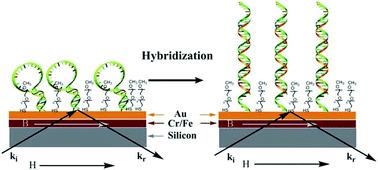Mixed self-assembled monolayers (mSAMs) have been successfully utilised as platforms for gene sensors, employing optical as well as electrochemical means of detection. Probe density is one of the most important parameters in the construction of such a sensor and thus a fundamental understanding of the structure within the mSAM is vital. In this work, the interfacial behaviour of mixed SAMs, where short PEG oligomers co-adsorbed to the surface with hairpin structured oligonucleotide (ODN) probes, has been investigated. The neutron reflectivity of the mixed SAMs was measured at differing HPP : PEG ratios, and through two routes of formation, to elucidate the effect of controlled HPP surface density on surface conformation of the probes and on the final hybridised ODN–HPP construct. General conclusions regarding the structure of the investigated SAMs could be drawn from determined thickness and volume fraction values and conformational changes in the mSAM, induced by hybridisation with complementary ODN, were also detected. An investigation of the melting behaviour of the surface-attached HPPs was also conducted with polarised neutron reflectivity and clear signs of melting were observed in the reflectivity and the SLD profiles around 45 °C.

You have access to this article
 Please wait while we load your content...
Something went wrong. Try again?
Please wait while we load your content...
Something went wrong. Try again?


 Please wait while we load your content...
Please wait while we load your content...